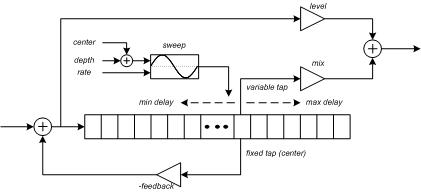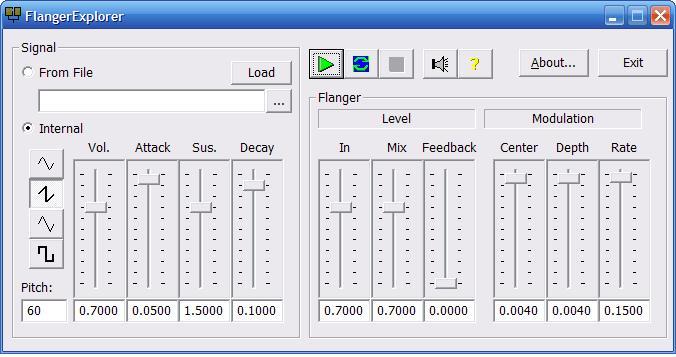Flangers
Flanging is a technique developed in analog recording that adds a delayed signal to the original signal by running two tape recorders in parallel. The speed of the tape recorders is varied by touching the flange of the tape reel, momentarily slowing down the recorder. Hence the name "flanging." The effect of flanging is to blend together two signals that are slightly offset in time and also varying in pitch. The variable phase shift between the two signals causes phase cancellation at different frequencies producing the classic "swoosh" sound.
Emulation of flanging is done using a variable delay line controlled by an oscillator. The following figure shows the basic structure for a flanger.

This setup provides several variable parameters. Depending on the settings, the flanger can produce a vibrato, chorus, flanger, or a siren-like warble effect. Depth values for a flanger effect will typically vary from 1 to 10ms with a center delay of 10ms or less and a very slow (.15 Hz) sweep rate. Chorus typically uses very small depth values but greater center values and faster sweep rates. Longer delays and wider range of delays produces a more dramatic effect, as does increasing the mixture of the delayed signal. As the center delay time increases, the sound acquires a distinct echo.
The sweep oscillator is used to move the variable tap back and forth around a nominal delay time (center). A typical sweep rate is slow, around 0.1 to 0.5Hz, but can vary from 0.01Hz up to around 10Hz at the maximum. (Beyond 10Hz the oscillator begins to introduce a FM effect.)
The output of the delay line is mixed with the input signal and the relative settings of the level and mix values will control the strength of the flanger effect. Setting the two values equal produces the typical "phasing" effect of a flanger. Decreasing the mix value relative to the level creates a more subtle flanger effect. A level setting of 0 takes all output from the delay line and produces a vibrato.
The feedback signal is optional and is used to affect the coloration of the flanger. From the discussion of filters, we know that mixing a delayed version of a signal with the original signal produces a comb filter with zeros at the phase cancelation points. The number of "teeth" in the comb filter increases with the number of delays. As the delay shifts back and forth, the comb filter expands and contracts producing a variable low-pass filter effect. This adds to the flanger effect, and is generally beneficial. However, the low-pass filtering effect can create a muffled sound and there may be times where we want to limit the frequency coloration. Just as the mix variable creates a FIR filter, the feedback variable creates a IIR filter. When the feedback value is negative and equal to the level setting, the result is an allpass filter. Varying the level, feedback and mix settings changes the sound from low-pass to all-pass to high-pass filtering effects and varies the coloration of the sound. In short, the feedback controls the "brightness" of the resulting sound.
The flanger explorer program implements a basic flanger and allows varying the parameters to experiment with different settings.
Download the Flanger Explorer program.

| 
